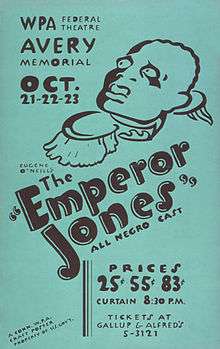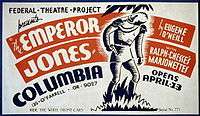The Emperor Jones
| The Emperor Jones | |
|---|---|
 Poster for a 1937 Federal Theater Project production | |
| Written by | Eugene O'Neill |
| Date premiered | 1 November 1920 |
| Place premiered |
Neighborhood Playhouse New York City, New York |
| Original language | English |
| Subject | A Black porter attains power in the West Indies by exploiting the superstitions and ignorance of an island's residents. |
| Genre | Tragedy |
| Setting | A West Indian island not yet self-determined, but for the moment, an empire. |


The Emperor Jones is a 1920 play by American dramatist Eugene O'Neill that tells the tale of Brutus Jones, a resourceful, self-assured African-American and a former Pullman porter, who kills another black man in a dice game, is jailed, and later escapes to a small, backward Caribbean island where he sets himself up as emperor. The play recounts his story in flashbacks as Brutus makes his way through the jungle in an attempt to escape former subjects who have rebelled against him.
The play is one of O'Neil's major experimental works, mixing expressionism and realism, and the use of an unreliable narrator and multiple points of view. It was also an oblique commentary on the U.S. occupation of Haiti after bloody rebellions there, an act of imperialism that was much condemned in O'Neill's radical political circles in New York.[1] The Emperor Jones draws on O'Neill's own hallucinatory experience hacking through the jungle while prospecting for gold in Honduras in 1909.[2]
It was O'Neill's first big box-office hit, and the one that established him as a successful playwright, after he won the Pulitzer Prize for Drama for his first play, also in 1920, the much less well-known Beyond the Horizon. The Emperor Jones was included in Burns Mantle's The Best Plays of 1920-1921.
Characters
- Brutus Jones
- Smithers
- Jeff
- Undine
- Dolly
- Lem
Summary
The play is virtually a monologue for its leading character, Jones, in a Shakespearean range from regal power to the depths of terror and insanity, comparable to Lear or Macbeth. Scenes 2 to 7 are from the point of view of Jones, and no other character speaks. The first and last scenes are essentially a framing device with a character named Smithers, a white trader who appears to be part of illegal activities. In the first scene, Smithers is told about the rebellion by an old woman, and then has a lengthy conversation with Jones. In the last scene, Smithers converses with Lem, the leader of the rebellion. Smithers has mixed feelings about Jones, though he generally has more respect for Jones than for the rebels. During the final scene, Jones is killed by a silver bullet, which was the only way that the rebels believed Jones could be killed, and the way in which Jones planned to kill himself if he was captured.
Productions
1920 premiere
The Emperor Jones was first staged on November 1, 1920, by the Provincetown Players at the Playwright's Theater in New York City.[3] Charles Sidney Gilpin, a respected leading man from the all-black Lafayette Players of Harlem, was the first actor to play the role of Brutus Jones on stage. They did have some conflict over Gilpin's tendency to change O'Neill's use of the word "nigger" to Negro and colored in the course of the play. This production was O'Neill's first real smash hit. The Players' small theater was too small to cope with audience demand for tickets, and the play was transferred to another theater. It ran for 204 performances and was hugely popular, and toured in the States with this cast for the next two years.
1924 revival
Although Gilpin continued to perform the role of Brutus Jones in the U.S. tour that followed the Broadway closing of the play, he eventually had a falling out with O'Neill. Gilpin wanted O'Neill to remove the word "nigger", which occurred frequently in the play, but the playwright felt its use was consistent with his dramatic intentions and the use of language was, in fact, based on a friend, an African-American tavern-keeper on the New London waterfront that was O'Neill's favorite drinking spot in his home town.[4] When they could not come to a reconciliation, O'Neill replaced the middle-aged Gilpin with the much younger and then unknown Paul Robeson, who had only performed on the concert stage. Robeson starred in the title role in the New York revival and in the London production. He received excellent reviews and, coupled with his performance in the 1928 London production of the musical Show Boat, went on to worldwide fame as one of the great black artists of the 20th century, while Gilpin faded into obscurity.
1926 revival
The show was again revived in 1926 at the Mayfair Theatre in Manhattan, with Gilpin again starring as Jones and also directing the show. The production, which ran for 61 performances, is remembered today for the acting debut of a young Moss Hart as Smithers.
Federal Theatre Project
The Federal Theatre Project of the Works Progress Administration launched several productions of the play in cities across the United States, including a production with marionettes in Los Angeles in 1938.[5]
Recent productions
In 1980 Richard Negri directed a production at the Royal Exchange, Manchester with Pete Postlethwaite and Albie Woodington.
The Wooster Group mounted a production of the play in 2007 for the Philadelphia LiveArts Festival, which played to sold-out audiences every night of its run. Along with its post-dramatic aesthetics, this staging was notable in that the actor playing the part of Jones, Kate Valk, was female, white, and performed in blackface — which had, ironically, been a suggestion for the original play, which O'Neill had vetoed.
The play ran for 33 performances at The National Theatre, directed by Thea Sharrock and starring Paterson Joseph in the lead.
New York's Irish Repertory Theatre staged a 2009 revival, which received overwhelmingly positive reviews. John Douglas Thompson portrayed Jones.
Film, television, opera and ballet adaptations
The play was adapted for a 1933 feature film starring Paul Robeson and directed by Dudley Murphy, an avant-garde filmmaker of O'Neill's Greenwich Village circle who pursued the reluctant playwright for a decade before getting the rights from him.
Louis Gruenberg wrote an opera based on the play, which was premiered at the Metropolitan Opera in New York City in 1933. Baritone Lawrence Tibbett sang the title role, performing in blackface. Paul Robeson's 1936 film Song of Freedom features a scene from the opera with Robeson singing the role of Jones. This has sometimes resulted in a confusion that the 1933 film of O'Neill's play is a film of the opera.
In the UK, BBC Television produced an adaptation in 1938, starring Robert Adams, and another in 1953, starring Gordon Heath.
Several revivals were made in the 1950s when Robeson himself was blacklisted, denied his passport by the State Department and his films — including the 1933 film — recordings and performances were banned in the United States; these new productions were implicitly in defiance of the persecution and suppression of this great star by McCarthyism and the FBI from 1950 until 1958, and part of a world-wide effort of artists to lift the ban.
First, the legendary New York actor Ossie Davis starred in a television adaptation for the Kraft Television Theatre in 1955 — this at a time when black faces were rarely seen on American television sets.
In 1956 Heitor Villa-Lobos wrote a ballet based on the play that was commissioned by The Empire Music Festival of New York, and danced by José Limón's company — Limon himself a revered teacher at Juilliard and breakthrough performer of color.
A live British television production by Associated Television for the first season of its Armchair Theatre series was seen on UK television on March 30, 1958.[6] It features African-American actor Kenneth Spencer, and was directed by the Canadian director Ted Kotcheff and adapted by the American "beat" novelist Terry Southern in his first screenwriting job. Unlike other British television versions, it still exists, and has been released on DVD.
An experimental video by Christopher Kondek and Elizabeth LeCompte showcases the production of the play by the New York-based performance troupe The Wooster Group, starring Kate Valk and Willem Dafoe.
References
- ↑ Renda, Mary (2001). Taking Haiti: Military Occupation and the Culture of U.S. Imperialism. Chapel Hill: University of North Carolina Press, pp. 198–212. ISBN 0-8078-4938-3.
- ↑ Arthur & Barbara Gelb, O'Neill - Life with Monte Cristo, NY (2000), p.
- ↑ Eoneill.com
- ↑ Arthur and Barbara Gelb, O'Neill, Life with Monte Cristo (NY, 2000), pp. 349–350.
- ↑ "Federal Theatre (Memory)". American Treasures of the Library of Congress. Library of Congress. 2008. Retrieved February 16, 2009.
- ↑ Laura Pearson, "Emperor Jones (1958)", BFI Screenonline.
Further reading
- O'Neill, Eugene (1920). The Emperor Jones (First ed.). New York: Random House. OCLC 29238831.
External links
- The Emperor Jones at the Internet Broadway Database
- The Emperor Jones at the Internet Broadway Database
- The Emperor Jones at the Internet Movie Database
- Discussion of Emperor Jones from Travus Bogard's book Contour in Time, on O'Neill.
- 1945 Theatre Guild on the Air radio adaptation at Internet Archive
